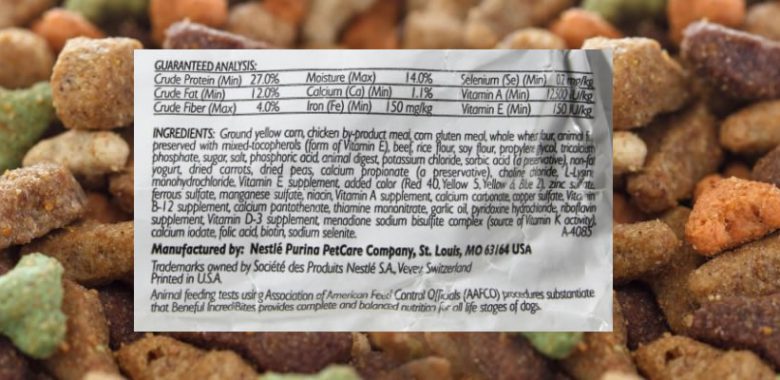
What's Really in Pet Food?
Additives and Preservatives
Many chemicals are added to commercial pet foods to improve the taste, stability, characteristics, or appearance of the food. Additives provide no nutritional value. Additives include emulsifiers to prevent water and fat from separating, antioxidants to prevent fat from turning rancid, and artificial colors and flavors to make the product more attractive to consumers and more palatable to their companion animals.
Adding chemicals to food originated thousands of years ago with spices, natural preservatives, and ripening agents. In the last 40 years, however, the number of food additives has greatly increased.
All commercial pet foods must be preserved so they stay fresh and appealing to our animal companions. Canning is a preserving process itself, so canned foods contain less preservatives than dry foods. Some preservatives are added to ingredients or raw materials by the suppliers, and others may be added by the manufacturer. Because manufacturers need to ensure that dry foods have a long shelf life to remain edible after shipping and prolonged storage, fats used in pet foods are preserved with either synthetic or “natural” preservatives. Synthetic preservatives include butylated hydroxyanisole (BHA) and butylated hydroxytoluene (BHT), propyl gallate, propylene glycol (also used as a less-toxic version of automotive antifreeze), and ethoxyquin . For these antioxidants, there is little information documenting their toxicity, safety, interactions, or chronic use in pet foods that may be eaten every day for the life of the animal.
Potentially cancer-causing agents such as BHA, BHT, and ethoxyquin are permitted at relatively low levels. The use of these chemicals in pet foods has not been thoroughly studied, and long term build-up of these agents may ultimately be harmful. Due to questionable data in the original study on its safety, ethoxyquin’s manufacturer, Monsanto, was required to perform a new, more rigorous study. This was completed in 1996. Even though Monsanto found no significant toxicity associated with its own product, in July 1997, the FDA’s Center for Veterinary Medicine requested that manufacturers voluntarily reduce the maximum level for ethoxyquin by half, to 75 parts per million. While some pet food critics and veterinarians believe that ethoxyquin is a major cause of disease, skin problems, and infertility in dogs, others claim it is the safest, strongest, most stable preservative available for pet food. Ethoxyquin is approved for use in human food for preserving spices, such as cayenne and chili powder, at a level of 100 ppm– but it would be very difficult to consume as much chili powder every day as a dog would eat dry food. Ethoxyquin has never been tested for safety in cats.
Some manufacturers have responded to consumer concern, and are now using “natural” preservatives such as Vitamin C (ascorbate), Vitamin E (mixed tocopherols), and oils of rosemary, clove, or other spices, to preserve the fats in their products. Other ingredients, however, may be individually preserved. Most fish meal, and some prepared vitamin-mineral mixtures, contain chemical preservatives. This means that your companion animal may be eating food containing several types of preservatives. Federal law requires preservatives to be disclosed on the label; however, pet food companies only recently started to comply with this law.
Additives in Processed Pet Foods
- Anticaking agents
- Antimicrobial agents
- Antioxidants
- Coloring agents
- Curing agents
- Drying agents
- Emulsifiers
- Firming agents
- Flavor enhancers
- Flavoring agents
- Flour treating agents
- Formulation aids
- Humectants
- Leavening agents
- Lubricants
- Non nutritive sweeteners
- Nutritive sweeteners
- Oxidizing and reducing agents
- pH control agents
- Processing aids
- Sequestrants
- Solvents, vehicles
- Stabilizers, thickeners
- Surface active agents
- Surface finishing agents
- Synergists
- Texturizers
While the law requires studies of direct toxicity of these additives and preservatives, they have not been tested for their potential synergistic effects on each other once ingested. Some authors have suggested that dangerous interactions occur among some of the common synthetic preservatives.
